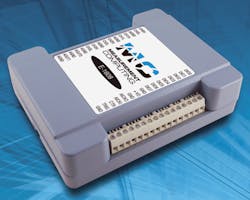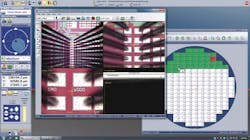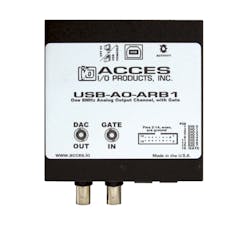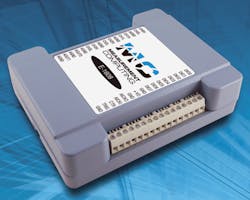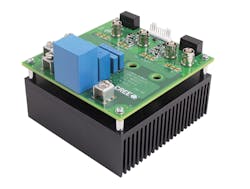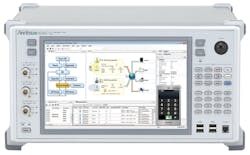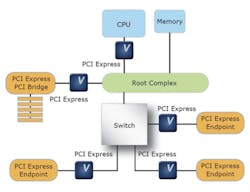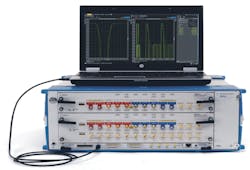Scope Enhancements
Enhancements to the R&S oscilloscope portfolio include new models, applications, and accessories. Among the enhancements is a high-definition mode that increases the vertical resolution of the R&S RTO and R&S RTE digital oscilloscopes to up to 16 bits via low-pass filtering—a 256-fold improvement over the 8-bit resolution available in the standard mode.
The company also has added a 200-MHz bandwidth model to its R&S RTM bench oscilloscope family. The history and segmented memory option, which expands the maximum memory depth to 460-Msample per channel, is available for all bandwidth models. A new digital voltmeter option enables the R&S RTM to measure values such as AC, DC, peak, and crest factor with three-digit accuracy regardless of the oscilloscope’s triggering. The scope now features a seven-digit frequency counter as well. Rohde & Schwarz
Probe-Station Control Software
Velox 2.0, the latest version of probe-station control software, combines the best attributes of the company’s Nucleus and ProberBench legacy probe-station control platforms and is backwards-compatible with all of the current probe systems. Velox 2.0 simplifies setup and execution of automated measurements using WaferSync, an exclusive two-way communication link between Velox and Keysight Technologies’ WaferPro Express automated on-wafer measurement software. Velox 2.0 can create an environment in which the prober is the common platform for the test executive, turning a probe system into the host for the test and measurement instrumentation.
The VeloxPro test automation software option sequences wafer handling, alignment, temperature control, Z-profiling, and stepping as a single automated test flow. Cascade Microtech
USB AWG Board
USB-AO-ARB1 is a new 8-MHz, 16-bit USB arbitrary waveform output board featuring flexible ranges and configurable digital I/O lines. BNC connectors are used for the analog waveform output and the gate control input. The USB-AO-ARB1 measures 3.550 x 3.775 inches and ships inside a steel powder-coated enclosure with an anti-skid bottom.
The OEM USB/104 option size and predrilled mounting holes match the PC/104 form factor (without the bus connections). This ensures easy installation using standard standoffs inside most enclosures or systems. The board also utilizes a high-speed custom function driver optimized for a maximum data throughput and includes a free Windows and Linux (including Mac OS X)-compatible software package with sample programs and source code in Visual Basic, Delphi, and Visual C++ for Windows. ACCES I/O
The new E-1608 Ethernet-based multifunction data-acquisition device provides both analog and digital I/O. It features 250-kS/s sampling and 16-bit resolution with eight analog inputs, eight digital I/O channels, one counter input, and two analog outputs. The device is supported in Windows and Android operating systems and will add Linux support in the near future. An OEM board-only version also is available.
Microsoft Windows software options for the E-1608 include DAQami and TracerDAQ to display and log data along with comprehensive support for C, C++, C#, Visual Basic, and Visual Basic .NET. Drivers for DASYLab and NI LabVIEW also are provided. Android support for the E-1608 allows users to develop DAQ applications for tablets and smart phones. Free sample applications are available for download on Google Play. $499. Measurement Computing
True-DC RF Switch
The UltraCMOS PE42020 is a single-pole double-throw (SPDT) true DC RF configurable 50-Ω absorptive or open reflective switch. It handles 30 dBm at 0 Hz and 36 dBm at 8 GHz. It also has linearity of 62 dBm IIP3, total harmonic distortion of -84 dBc, and a 0.1-dB power compression point of 38 dBm at 8 GHz. The PE42020 features a 10-μs switching time, a settling time of 35 μs, and an ESD rating of 1,000 V HBM on all pins. In addition, it can handle DC or AC peak voltages in the range of +10 V to -10 V on the RF ports and DC current through RF active ports of up to 80 mA. Offered in a RoHS-compliant, 20-lead 4 mm x 4 mm QFN, the PE42020 is $14 each for 1k-quantity orders and $11.35 each for 5k-quantity orders. Peregrine Semiconductor
A new silicon carbide (SiC) MOSFET design kit facilitates evaluation of the company’s MOSFET and Schottky diode performance in a configurable half-bridge circuit. The kit provides easy access to critical test points, enabling simple and accurate measurements including VGS, VDS, and IDS, and is easily configured to several different buck or boost power conversion topologies.
The kit features two 80-mΩ, 1,200-V MOSFETs; two 1,200-V, 20-A Schottky diodes in standard TO-247 packages; a half-bridge-configured design board equipped with isolated gate drives; power supplies; and all of the other components necessary to assemble the power stage. Also included are a gate driver schematic and layout reference for a TO-247-packaged MOSFET and a comprehensive user manual and sourcing sheet with basic block diagrams and specifications. Cree
Emergency and Public Warning Test
The MD8475A signaling tester with SmartStudio Manager Windows-based control software now provides multi-operator support for Commercial Mobile Alert System (CMAS) Carrier Acceptance Test (CAT) packages. Separate packages offer 2G, 3G, and LTE radio technology support. By simulating a real-world network environment, the MD8475A establishes a simple, cost-efficient, and accurate process for validating UE performance.
The MD8475A is a complete network-in-a-box, simulating the radio access as well as the core network and server functions, and supports the full range of communications standards. Running the MX847503A
SmartStudio Manager software on a PC with Windows allows simultaneous execution of multiple test cases and at-a-glance display of test results. The MD8475A and SmartStudio Manager combine to provide engineers involved with each carrier’s ecosystem a cost-effective platform for CMAS and other application tests. LTE, LTE-Advanced, W-CDMA/HSPA/HSPA Evolution/DC-HSDPA, GSM/EGPRS, CDMA2000 1X/1xEV-DO Rev. A, and TD-SCDMA/TD-HSPA are supported by the MD8475A. Anritsu
Signal Conditioner
The new VSC7112 8.5-Gb/s VSC7112 quad-channel signal conditioner is targeted at signal-integrity challenges related to blade servers, enterprise storage, and cloud computing. The VSC7112 repeater is claimed to deliver increased layout flexibility and overall lower systems costs in applications where short PCIe links are not possible.
Based on a production-proven silicon platform with a failure-in-time rate well below 10 ppm, the VSC7112 delivers input equalization and output pre-emphasis enabling 30-dB loss compensation over a 50-inch channel with multiple connectors. This ensures sufficient system margin over and reliable connectivity between PCIe hosts and peripherals. Independent testing has confirmed the applicability of the VSC7112 in PCIe Gen 3.0 repeater applications. Vitesse Semiconductor
IP, TDM, and PSTN Fax Testing
Fax Testing Solutions over IP, TDM, and PSTN networks accommodate technology communication over a wide variety of networks. Support for simulation of Fax over IP in the pass-through mode (using G.711 PCMU and PCMA) is based on the vendor’s MAPS standard framework for emulating signaling and traffic associated with IP, TDM, and wireless protocols.
The recently introduced bulk (100s) call Fax Emulator software is capable of transmitting and receiving faxes over many T1 E1 timeslots or through two-wire FXO and FXS lines. The FaxScan application processes two-wire and four-wire voice-band capture for T.30 frames and PCAP captures for T.38 packets. Users can extract a fax TIF image and decode general call-flow indicators for detail analysis. PacketScan software supports capturing and decoding of fax (T.38 data) calls over VoIP.
GLInsight also helps in decoding and analysis of prerecorded fax transmissions. GL Communications
BERT with ISI Capability
The J-BERT M8020A high-performance BERT now has an adjustable and integrated inter-symbol interference (ISI) capability. All high-speed digital receivers are specified to tolerate a certain amount of total jitter, which typically includes some ISI caused by channel loss. During receiver characterization and compliance test, engineers need to emulate this loss. Each pattern-generator channel of the J-BERT M8020A allows engineers to emulate a certain channel loss.
The J-BERT M8020A accelerates insight into digital designs. It offers fast and accurate receiver characterization for single- and multilane devices operating at data rates up to 16-Gb/s and 32-Gb/s. The built-in ISI functionality is programmable for each pattern-generator channel, simplifying receiver test automation by eliminating cabling and switching of external traces for data rates up to 16-Gb/s. Keysight Technologies
Medical Imaging
The Embedded Radeon HD 7850 GPU with OpenCL enables cutting-edge application performance for the Analogic bk3000 ultrasound system. Analogic accessed the GPU via OpenCL to achieve a 3x improvement in the amount of information in each ultrasound image and reduce time from capture to presentation. Going to a software-based solution using OpenCL helps to lower the development cost and provides improved long-term value because the software can be used across product lines and through generation shifts.
The Embedded Radeon HD 7850 is based on the company’s Graphics Core Next architecture to advance the visual growth and parallel processing capabilities of embedded applications. In addition to ultrasound, other uses include complex parallel applications such as terrain and weather mapping, facial and gesture recognition, and biometric and DNA analysis. AMD
